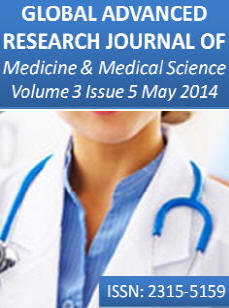|

May 2014 Vol. 3 Issue
5
Other viewing option
Abstract
•
Full
text
•Reprint
(PDF) (220 KB)
Search Pubmed for articles by:
Habib FM
Al-Mutairi WM
Other links:
PubMed Citation
Related articles in PubMed
|
|
Global Advanced Research Journal
of Medicine and Medical Sciences (GARJMMS) ISSN: 2315-5159
May 2014 Vol. 3(5), pp.
095-101
Copyright © 2014 Global Advanced
Research Journals
Full Length Research Paper
|
Vitamin D Deficiency: Knowledge and Practice among
Adult Saudi Females
Farida M. Habib1*,
Wjdan A. Al-Motairi2 and Wadaa M.
Al-Mutairi2
1Maternity
Health Nursing Department King Saud bin Abdulaziz
University for Health Sciences – Riyadh, Kingdom of
Saudi Arabia
2Undergraduate
Nursing Student, College of Nursing, King Saud bin
Abdulaziz University for Health Sciences – Riyadh,
Kingdom of Saudi Arabia
*corresponding Author E-mail:
fmh226@yahoo.com; Tel. No.: +966 1 8011111 Ex.
51205; Cell Phone: +966531430949
Accepted 09 April, 2014
|
|
Abstract |
|
This study is
to assess the knowledge and practice of Saudi female
about vitamin D deficiency.
This study used descriptive designs. Convenience
sample of 310 Saudi Females aged 20 and above were
included in the study. The sample size was estimated
using sample size calculator. Three tools were
developed to collect data namely: Sociodemographic
questionnaire, Knowledge assessment tool, Practice
Assessment tool. The validity and reliability of the
tools were ensured. The participants were aware
about the aim of the study. Verbal agreement
(consents) was taken before data collection. Data
was coded for entry and analysis using SPSS
statistical software package version 18. The mean
age of the sample was 25.18+ 6.7 years old.
About one third (29%) of the sample had correct
information about importance of Vitamin D, While
only 19% use vitamin D supplement. Forty six
percent of the subjects do not expose themselves to
sun daily, while out of those who expose to sun
daily 16.6% expose to sun less than 10 minutes.
There was a significant positive correlation between
knowledge of females and their practices toward
prevention of vitamin D deficiency (p = 0.000).
Younger females had better knowledge and practice
scores as there were negative relationship between
age and both knowledge, and practice total scores (p
= 0.000, P = 0.014). Knowledge of females to prevent
Vitamin D deficiency was insufficient. Age was an
indicator for females’ knowledge and practice. More
emphasis should be carried out to improve female’s
knowledge and practice.
Keywords:
vitamin D deficiency, knowledge and practice, Saudi
females.
|
| |
|
